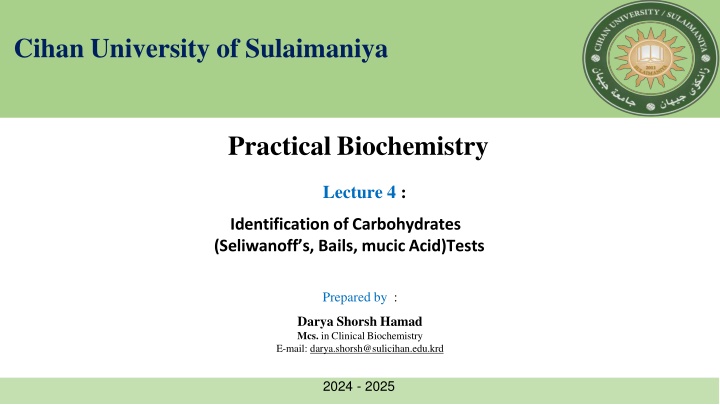
Practical Biochemistry: Carbohydrate Identification Tests Overview
Learn about Seliwanoff's, Bial's, and Mucic Acid tests for carbohydrate identification in biochemistry. Understand the principles, reagents, procedures, and aims of these tests. Enhance your knowledge of distinguishing between sugars based on functional groups and reactions.
Download Presentation

Please find below an Image/Link to download the presentation.
The content on the website is provided AS IS for your information and personal use only. It may not be sold, licensed, or shared on other websites without obtaining consent from the author. If you encounter any issues during the download, it is possible that the publisher has removed the file from their server.
You are allowed to download the files provided on this website for personal or commercial use, subject to the condition that they are used lawfully. All files are the property of their respective owners.
The content on the website is provided AS IS for your information and personal use only. It may not be sold, licensed, or shared on other websites without obtaining consent from the author.
E N D
Presentation Transcript
Cihan University of Sulaimaniya Practical Biochemistry Lecture 4 : Identification of Carbohydrates (Seliwanoff s, Bails, mucic Acid)Tests Prepared by : Darya Shorsh Hamad Mcs. in Clinical Biochemistry E-mail: darya.shorsh@sulicihan.edu.krd 2024 - 2025
Seliwanoffs test Aim of Seliwanoff s test: is used to differentiate between sugars that have a ketone group (ketose) and sugars that have an aldehyde group (aldoses). It gives a positive result for ketoses because they tend to dehydrate more quickly compared to aldoses. Seliwanoff s Reagent: The reagent of this test consists of resorcinol and concentrated HCl. Principle: This is a specific test for ketohexoses. Concentrated HCl dehydrates ketohexoses to form furfural derivatives which condense with resorcinol to give cherry red color solution. Aldoses may react slightly to produce a faint pink color.
Procedure of Seliwanoffs Test: 1- Add 3 ml of Seliwanoff s reagent (a solution of resorcinol and HCl) into each of four separate test tubes. 2 Add 3 drops of 1% solutions of fructose, glucose, sucrose and starch , one sugar solution per tube . mix the contents of the tubes. 3 Heat the tubes in a boiling water bath for 1 minute and then cool tubes under tap water.
Bials Test Aim: This test is used to distinguish between pentose sugar from hexose Reagents: Bial's reagent consists of orcinol, concentrated hydrochloric acid (HCl) and ferric chloride. Principle: In the presence of concentrated HCl, pentose react to give furfural, whereas hexoses give 5-hydroxymethyfurfural, as we have just seen. Furfural reacts with orcinol and ferric ions, which are present in Bial s reagent, along with conc. HCl, to give a blue-green color.
BialsTest Procedure 1. Take 1 ml of Test sugar solutions in test tubes 2. Add 2.5 ml of Bial s reagent to each tube and heat in a boiling water bath for 1min 3. allow the tubes to cool down. Look for the formation of blue-green color.
Mucic acid Test Aim: This test is specifically used to detect galactose. Mucic acid has also another name ( Galataric acid). Reagent: concentrated nitric acid. Principle: Monosaccharides like galactose, (galactose containing sugars such as lactose gives positive response to this reaction) in the presence of strong acids like nitric acid, produce saccharic acids. The saccharic acid formed is insoluble and form clear crystals. This acid derivative is known as galactaric or meso-galactaric acid (mucic acid), thus the name for the test.
Procedure 1. Mix 3 drops of the carbohydrate solution (galactose and lactose) and 3 drops of the concentrated Nitric Acid on a glass slide 2. Pass the mixture over a small flame until it is almost dry. Cool the mixture at room temperature; examine the crystals under the microscope.
Lab Questions Q1: we did the following tests for each of Solution maltose and ribose give the results and explanation for each solutions. Mucic Benedict Barfoed Bial Selliwanoff Q2: What are carbohydrates give positive result with Seliwanoff ? why? Q3: What is the result of Bial's test if the sample contain starch?why?
